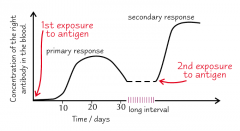![]()
![]()
![]()
Use LEFT and RIGHT arrow keys to navigate between flashcards;
Use UP and DOWN arrow keys to flip the card;
H to show hint;
A reads text to speech;
7 Cards in this Set
- Front
- Back
|
How do antibodies help clear an infection? |
|
|
|
The primary response is... |
... slow |
|
|
Explain what the primary response is and why is slow/fast, and why it is harder to get ill again. |
|
|
|
The secondary response is... |
...fast |
|
|
Explain what the secondary response is and why is slow/fast and what occurs during the secondary response. |
|
|
|
Summarise into a table the primary and secondary responses. Divide the table into Pathogen, Speed of response, cells activated and symptoms. |

|
|
|
Draw a graph showing the concentration of the right antibody against the y-axis and the time and days during the x-axis. Show the primary and secondary examples. |

|

